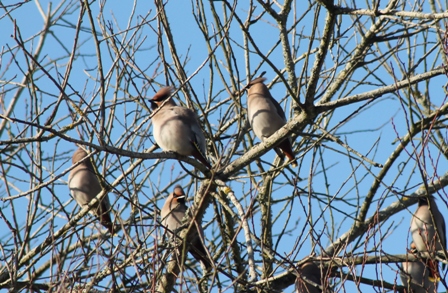Bohemian Waxwing (Bombycilla garrulus)
The silky-plumaged Waxwing, as well turned out as a Parisian lady leaving a beauty parlour, with its black eye-shadow, hair-dried crest and wings duly waxed, is the only European bird that can subsist for months on end entirely upon fruit. A good many other birds eat huge quantities of berries in the autumn and winter, among them thrushes, starlings and warblers, but every one of these must take in some invertebrates as a supplement during this period. Not so the Waxwing – it is a specialist, single-minded frugivore.
It has one main adaptation to its unusual diet, and that is an unusually wide gape for a bird of its size – 11 mm in width, the same as that of a Fieldfare, although the latter is twice as heavy. This enables it to pluck just about every type of fruit available in the wild, and those it cannot pluck, such as apples, its thick bill enables it to pick at, taking chunks out of them where they grow. On an average winter day a Waxwing will eat between 600 and 1000 berries, approximately double its body weight.
In the breeding season the Waxwing’s diet alters considerably. In the northern taiga where it nests, mosquitoes and midges are exceedingly abundant, and for a few months the Waxwing subsists largely upon these instead. It obtains them by fly-catching, leaving a high perch on an aerial sally and snapping them up in flight. Later on, it may use this same skill to catch falling snowflakes, since its usual diet requires it to drink a considerable amount of fluid.
Waxwings nest very late in the season, rarely before June. This is because the birds need to await the arrival of summer fruits to nourish themselves and their young, although both take insects as well both during and after breeding. As a result of relying on food that is patchily distributed in their environment, Waxwings eschew territoriality and often forage together, well away from the nest, in groups.
At the end of the breeding season the shift back towards a solely frugivorous diet happens slowly, and is dependent on weather conditions and insect supplies. Eventually, though, as autumn bites, the birds once again acquire their tunnel vision, and become particularly dependent on the berries of rowan. The supply of these will determine their movements for the following months. If stocks are high the birds will remain in the taiga zone, not far from where they bred. If stocks are poor, however, and the birds have also had a good breeding season, the density of birds competing for the same resource becomes untenable, and large numbers then evacuate south in search of berries in temperate regions of Europe. These evacuations are known as “eruptions”, and often take the birds well to the south of their normal wintering range.
The Waxwing’s unusual coloration is related, as is so much of its biology, to its diet. The yellow and red patches – the latter looking like waxy blobs on the tips of the secondary feathers – are made from carotenoid pigments present in fruit. Older birds have more coloration than younger birds, and males more than females, so it is likely that the feature is used for sexual selection.
WAXWING Bombycilla garrulus (Family Bombycillidae)
Habitat In breeding season boreal forest, especially of old trees well spread out and with a copious layer of ground vegetation.
Food Insects in summer, especially mosquitoes and midges; in winter, almost entirely fruit – unusual for subsisting on little else at this time.
Movements Partial migrant subject to irruptions from time to time southward (see above).
Voice Call a high pitched trill; song an elaboration of this.
Pairing style Monogamous.
Nesting Usually solitary but not very territorial, and pairs often nest close together.
Nest Cup of thin conifer twigs, Reindeer Moss and grass, lined with grass. Placed in conifer tree 3-15 m above ground, usually close to stem.
Productivity 1 brood a year.
Eggs 5-6.
Incubation 14-15 days, by female only, fed by male.
Parenting style Both adults tend and feed the young.
Young Nest-bound, altricial and naked.
Food to young Regurgitated insects and berries.
Leaving nest Young leave at 14-15 days

